|
Bikes have
personalities - no argument about that. Some bikes have a tendency to wash
out, or lose the front end in the corners, while others have a front end
that "bites" and is very precise. This is not to say that either
one of these traits is superior to the other, but rather, points out a
genuine difference in the way the machine reacts to a forced situation.
Bikes that track
well at high speeds are highly desired for desert racing. Bike that turn
ultra-sharp are desirable for the tight twisty confines of stadium racing.
However, most bikes
are delivered to handle in an "average" fashion, to suit the
vast majority of riders. But you can dramatically alter the way your bike
handles, without spending a dime. All it takes is the tools you have in
your garage and a bit of knowledge.
Let's take a look at
what the advantages and disadvantages of the two traits are, disregarding,
for a moment, neutral handling bikes.
Okay. Remember those
long-legged Husqvarnas from a few years back? They had a whole bunch of
rake and lordy, did they ever go swell in a straight line at high speeds.
However, if you wanted to turn one of them suckers, you had to do it like
a scrambles rider: power on with a foot down and the rear end hung out.
Not every rider
could master this type of turning, and on bumpy corners, it took nerves of
steel, or very little in the way of brains. Hence, those Huskys that
worked just fine in desert racing (where you don't have to make many tight
turns), they were not exactly a roaring success on the motocross track, no
matter what your old Husky friends tell you.
At the opposite end
of the scale, you'll find bikes like the Honda motocross bikes of most any
year. Their front ends do not wash out in turns, unless the rider is doing
something drastically wrong. Sounds wonderful, doesn't it? Aha! They pay a
penalty for this precision in the corners. At high speeds over rough
ground, a typical CR-250 moves around a great deal. How shall we say it?
Err, ahh . . . the ass end is all over the place.
This, then, makes
the CR ideal for turning quickly on tight corners, and frankly, miserable
in high-speed desert or cross country racing. How many CRs have you seen
in the winner's circle at the Baja events? At these high-speed races,
Honda uses big old XR 650s, which have the turning manners of an ocean
liner.
The biggest reason bikes handles like they do, other than wheelbase,
center of gravity and vehicle weight, is what kind of rake and trail is
designed into the bike.
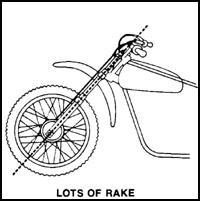
Figure
A |
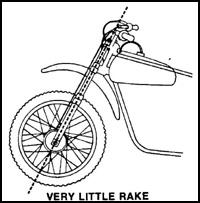
Figure
B |
For an idea of what
a lot of rake is, take a look at the poorly drawn illustration we have
unimaginatively labeled Figure A. Here you have a bike with a lot of rake
- a bike that wants to go straight and one that probably won't turn worth
a rat's butt.
Figure B shows a
bike's front end that has very little rake. You could expect this front
end to bite, all other things being equal. For a moment, disregard all
other factors. We know things like suspension, tires, swingarm length and
wheelbase affect handling too, but let's talk about front-end adjustments
first.
Now, let's say that
you own a bike and you don't like the way the front end is responding to
your particular style of riding. Obviously, you can take a torch and
change the steering head angle. Which will, in turn, change the rake,
which will, in turn, change the bike's handling.
But this is a little
radical, don't you think? After all, not everyone has a set of torches
lying around, and we are firm believers that the less you weld on a frame,
the better it is.
This still leaves
you several options that allow you a certain choice of chassis adjustment.
Most bikes have fork legs that will slide up and down (to some degree) in
their triple clamps.
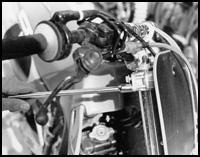
Loosen
up all the pinch bolts on the triple clamps to let the forks slide
up or down to alter handling. |
For the sake of
discussion, take a close look at a normal Yamaha MXer. With the forks
fully extended (that is, with the top of the fork leg even with the top of
the triple clamp), the Yamaha will experience a slight tendency to plow
and push the front end. By loosening up the pinch bolts and slipping the
legs up about ten millimeters, the bike will now turn like a demon! Make
sure you get the fork legs even. Any misalignment will cause uneven
reaction in the front wheel when the forks take a full stroke. Some
reasonable care must be taken when making these kinds of adjustments, and
they should be made in small increments.
Don't raise the
forks up too far. There is a point where the fender will start making
contact with the tire. This is not desirable.
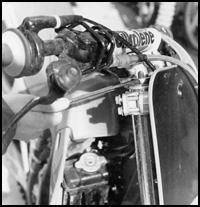
Here's
a good way to measure how much you moved things around: use the
tip of the wrench to make sure things are even on both forks. |
On some bikes,
you'll find that the forks can only be raised up a small amount, because
the bars are in the way. Two choices here: Bend the stock bars slightly,
or get bars that are swept back to clear the fork tops. It's a cheap
investment considering the benefits gained.
For the other end of
the handling scale, let's assume you have a quick handling bike and you
wish to do some high-speed desert work. Then the forks should be extended
as far as possible. The more they extend, the straighter the bike should
track. Many bikes have fork legs that at first glance do not appear
adjustable. However, in many cases, minor filing or machining can make
them fully adjustable. Just be sure that you have good strong pinch bolts
on the triple clamps.
If your forks are
already fully extended and you still want to slow the front end down more,
consider a change elsewhere in the chassis. Many people cut a frame, when
all they really had to do was install a shorter shock in the rear.
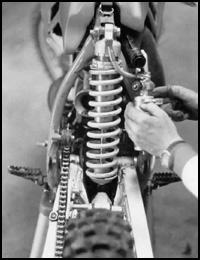
Shock
pre-load can dramatically change the way your bike handles. |
A shorter shock(s)
in the rear of any bike will make the machine hunker down and, in effect,
give a slight increase in rake. Just make sure you don't go too far and
have the rear tire hit the fender. A half-inch makes a huge difference
either way.
Before you even
think about a shorter shock(s), consider trying pre-load adjustments to
alter the handling. Crank a lot of pre-load into the shock, and the front
end will tend to bite better. Reduce the amount of pre-load, and the bike
will track straighter and turn less sharp.
More adjustments?
Well, you can always move your rear axle about two inches front to rear.
If you run the axle far forward, this gives the shock greater
"strength" and lets the bike turn sharper. If the axle is moved
all the way to the rear of the slot, the shock will act "weaker"
and the bike will track straighter.
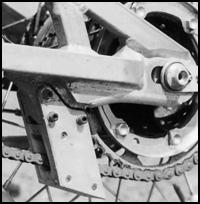
Most
bikes allow a few inches adjustment in the rear wheel position,
which results in big changes in handling. |
As you can see, you
now have a combination of fork height, shock pre-load, and wheelbase
length to consider.
But wait, as they
say on TV, there's more!
Want to adjust your
chassis even further without resorting to the torch? Consider. Some tires
are taller than others. That's right. You can literally adjust your
chassis by having a lower profile tire up front and a tall knobbied tire
on the back. Or the other way around, if that's your goal.
So before you take
the saw and the flame to your frame, think about the many adjustments you
can make with a wrench.
|